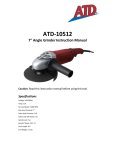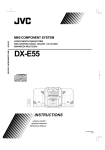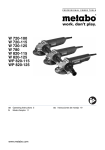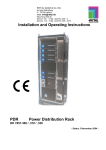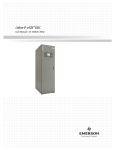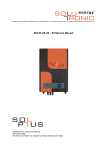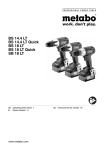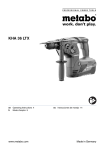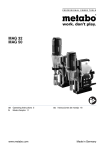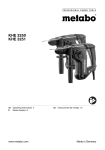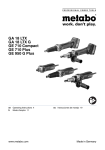Download Metabo W 720-115 Operating instructions
Transcript
W 720-100 W 720-115 W 720-125 W 780 W 820-115 W 820-125 WP 820-115 WP 820-125 en Original instructions 11 www.metabo.com 3 4 5 6 2 WP 820 1 7 8 9 1 10 A 1 A 9 12 B 9 B 8 11 12 2 C 13. mm (in) Dmax W 820-115 W 820-125 WP 820-115 WP 820-125 115 (4 1/2) 125 (5) 115 (4 1/2) 125 (5) 6 ; 6 (1/4 ; 1/4) M 14 / 16,5 (21/32) 6 ; 6 (1/4 ; 1/4) M 14 / 16,5 (21/32) tmax1; tmax3 mm (in) M/l - / mm (in) n min-1 (rpm) 11000 10000 11000 10000 P1 W 820 820 820 820 P2 W 510 510 510 510 m kg (lbs) 1,6 (3.5) 1,7 (3.7) 1,6 (3.5) 1,7 (3.7) ah,SG/Kh,SG m/s2 8 / 1,5 8 / 1,5 8 / 1,5 8 / 1,5 ah,DS/Kh,DS m/s2 4 / 1,5 4 / 1,5 3 / 1,5 3 / 1,5 LpA/KpA dB(A) 85 / 3 85 / 3 87 / 3 87 / 3 LWA/KWA dB(A) 96 / 3 96 / 3 98 / 3 98 / 3 W 720-100 W 720-115 W 720-125 W 780 13. Dmax mm (in) 100 (4) 115 (4 1/2) 125 (5) 125 (5) tmax1; tmax3 mm (in) 6 ; 6 (1/4 ; 1/4) 6 ; 6 (1/4 ; 1/4) 6 ; 6 ( 1 /4 ; 1 /4 ) 6 ; 6 (1/4 ; 1/4) M/l - / mm (in) M 10 / 16 (5/8) M 14 / 16 (5/8) M 14 / 16 (5/8) M 14 / 16,5 (21/32) n min-1 (rpm) 11000 11000 10000 10000 P1 W 720 720 720 780 P2 W 430 430 430 460 m kg (lbs) 1,5 (3.3) 1,5 (3.3) 1,6 (3.5) 1,7 (3.7) ah,SG/Kh,SG m/s 2 8 / 1,5 8 / 1,5 8 / 1,5 8 / 1,5 ah,DS/Kh,DS m/s2 3 / 1,5 3 / 1,5 3 / 1,5 4 / 1,5 LpA/KpA dB(A) 87 / 3 87 / 3 87 / 3 85 / 3 LWA/KWA dB(A) 98 / 3 98 / 3 98 / 3 96 / 3 EN 60745 2006/42/EG, 2004/108/EG, 2011/65/EU 2012-09-10 Volker Siegle Director Product Engineering & Quality Responsible Person for Documentation Metabowerke GmbH, 72622 Nuertingen, Germany 3 (8) A (1) (9) (10) Dmax= 100 mm 6.30813000 Dmax= 115 mm 6.30814000 Dmax= 125 mm 6.30815000 B 6.30327 C 4 (M 14) 6.30706 (M 10) 34110205 Original instructions 1. Conformity Declaration We, being solely responsible, hereby declare that these angle grinders conform to the standards and directives specified on page 3. 2. Specified Use Machines fitted with original Metabo accessories are suitable for grinding, sanding, separating and wire brushing metal, concrete, stone and similar materials without the use of water. The user bears sole responsibility for damage caused by improper use. Generally accepted accident prevention regulations and the enclosed safety information must be observed. 3. General Safety Instructions For your own protection and for the protection of your electrical tool, pay attention to all parts of the text that are marked with this symbol! WARNING – Reading the operating instructions will reduce the risk of injury. WARNING Read all safety warnings and instructions. Failure to follow all safety warnings and instructions may result in electric shock, fire and/or serious injury. Keep all safety instructions and information for future reference. Pass on your electrical tool only together with these documents. 4. Special Safety Instructions 4.1 Safety Warnings Common for Grinding, Sanding, Wire Brushing or Abrasive Cutting-Off Operations: Use a) This power tool is intended to function as a grinder, sander, wire brush or cut-off tool. Read all safety warnings, instructions, illustrations and specifications provided with this power tool. Failure to follow all instructions listed below may result in electric shock, fire and/or serious injury. b) Operations such as polishing are not recommended to be performed with this power tool. Operations for which the power tool was not designed may create a hazard and cause personal injury. c) Do not use accessories which are not specifically designed and recommended by the tool manufacturer. Just because the accessory can be attached to your power tool, it does not assure safe operation. ENGLISH en d) The rated speed of the accessory must be at least equal to the maximum speed marked on the power tool. Accessories running faster than their rated speed can break and fly apart. e) The outside diameter and the thickness of your accessory must be within the capacity rating of your power tool. Incorrectly sized accessories cannot be adequately guarded or controlled. f) The arbour size of wheels, flanges, backing pads or any other accessory must properly fit the spindle of the power tool. Accessories with arbour holes that do not match the mounting hardware of the power tool will run out of balance, vibrate excessively and may cause loss of control. g) Do not use a damaged accessory. Before each use inspect the accessory such as abrasive wheels for chips and cracks, backing pad for cracks, tear or excess wear, wire brush for loose or cracked wires. If power tool or accessory is dropped, inspect for damage or install an undamaged accessory. After inspecting and installing an accessory, position yourself and bystanders away from the plane of the rotating accessory and run the power tool at maximum no-load speed for one minute. Damaged accessories will normally break apart during this test time. h) Wear personal protective equipment. Depending on application, use face shield, safety goggles or safety glasses. As appropriate, wear dust mask, hearing protectors, gloves and a workshop apron capable of stopping small abrasive or workpiece fragments. The eye protection must be capable of stopping flying debris generated by various operations. The dust mask or respirator must be capable of filtrating particles generated by your operation. Prolonged exposure to high intensity noise may cause hearing loss. i) Keep bystanders a safe distance away from work area. Anyone entering the work area must wear personal protective equipment. Fragments of workpiece or of a broken accessory may fly away and cause injury beyond immediate area of operation. j) Hold power tool by insulated gripping surfaces only, when performing an operation where the cutting accessory may contact hidden wiring or its own cord. Cutting accessory contacting a "live" wire may make exposed metal parts of the power tool "live" and shock the operator. k) Position the cord clear of the spinning accessory. If you lose control, the cord may be cut or snagged and your hand or arm may be pulled into the spinning accessory. I) Never lay the power tool down until the accessory has come to a complete stop. The spinning accessory may grap the surface and pull the power tool out of your control. 11 en ENGLISH m) Do not run the power tool while carrying it at your side. Accidental contact with the spinning accessory could snag your clothing, pulling the accessory into your body. n) Regularly clean the power tool’s air vents. The motor’s fan will draw the dust inside the housing and excessive accumulation of powdered metal may cause electrical hazards. o) Do not operate the power tool near flammable materials. Sparks could ignite these materials. p) Do not use accessories that require liquid coolants. Using water or other liquid coolants may result in electrocution or shock. 4.2 Kickback and Related Warnings: Kickback is a sudden reaction to a pinched or snagged rotating wheel, backing pad, brush or any other accessory. Pinching or snagging causes rapid stalling of the rotating accessory which in turn causes the uncontrolled power tool to be forced in the direction opposite of the accessory’s rotation at the point of the binding. For example, if an abrasive wheel is snagged or pinched by the workpiece, the edge of the wheel that is entering into the pinch point can dig into the surface of the material causing the wheel to climb out or kick out. The wheel may either jump toward or away from the operator, depending on direction of the wheel’s movement at the point of pinching. Abrasive wheels may also break under these conditions. Kickback is the result of power tool misuse and/or incorrect operating procedures or conditions and can be avoided by taking proper precautions as given below. a) Maintain a firm grip on the power tool and position your body and arm to allow you to resist kickback forces. Always use auxiliary handle, if provided, for maximum control over kickback or torque reaction during start-up. The operator can control torque reactions or kickback forces, if proper precautions are taken. b) Never place your hand near the rotating accessory. Accessory may kickback over your hand. c) Do not position your body in the area where power tool will move if kickback occurs. Kickback will propel the tool in direction opposite to the wheel’s movement at the point of snagging. d) Use special care when working corners, sharp edges etc. Avoid bouncing and snagging the accessory. Corners, sharp edges or bouncing have a tendency to snag the rotating accessory and cause loss of control or kickback. e) Do not attach a saw chain woodcarving blade or toothed saw blade. Such blades create frequent kickback and loss of control. 4.3 Safety Warnings Specific for Grinding and Cutting-Off Operations: a) Use only wheel types that are recommended 12 for your power tool and the specific guard designed for the selected wheel. Wheels for which the power tool was not designed cannot be adequately guarded and are unsafe. b) The guard must be securely attached to the power tool and positioned for maximum safety, so the least amount of wheel is exposed towards the operator. The guard helps to protect the operator from broken fragments, accidental contact with the wheel and sparks that could ignite clothing. c) Wheels must be used only for recommended applications. For example: do not grind with the side of cut-off wheel. Abrasive cut-off wheels are intended for peripheral grinding, side forces applied to these wheels may cause them to shatter. d) Always use undamaged wheel flanges that are of correct size and shape for your selected wheel. Proper wheel flanges support the wheel thus reducing the possibility of wheel breakage. Flanges for cut-off wheels may be different from grinding wheel flanges. e) Do not use worn down wheels from larger power tools. Wheels intended for larger power tools are not suitable for the higher speed of a smaller tool and may burst. 4.4 Additional Safety Warnings Specific for Abrasive Cutting-Off Operations: a) Do not “jam” the cut-off wheel or apply excessive pressure. Do not attempt to make an excessive depth of cut. Overstressing the wheel increases the loading and susceptibility to twisting or binding of the wheel in the cut and the possibility of kickback or wheel breakage. b) Do not position your body in line with and behind the rotating wheel. When the wheel, at the point of operation, is moving away from your body, the possible kickback may propel the spinning wheel and the power tool directly at you. c) When wheel is binding or when interrupting a cut for any reason, switch off the power tool and hold the power tool motionless until the wheel comes to a complete stop. Never attempt to remove the cut-off wheel from the cut while the wheel is in motion otherwise kickback may occur. Investigate and take corrective action to eliminate the cause of wheel binding. d) Do not restart the cutting operation in the workpiece. Let the wheel reach full speed and carefully reenter the cut. The wheel may bind, walk up or kickback if the power tool is restarted in the workpiece. e) Support panels or any oversized workpiece to minimize the risk of wheel pinching and kickback. Large workpieces tend to sag under their own weight. Supports must be placed under the workpiece near the line of cut and near the edge of the workpiece on both sides of the wheel. f) Use extra caution when making a "pocket cut" into existing walls or other blind areas. The protruding wheel may cut gas or water pipes, electrical wiring or objects that can cause kickback. ENGLISH en 4.5 Safety Warnings Specific for Sanding Operations: a) Do not use excessively oversized sanding disc paper. Follow manufacturers recommendations when selecting sanding paper. Larger sanding paper extending beyond the sanding pad presents a laceration hazard and may cause snagging, tearing of the disc or kickback. 4.6 Safety Warnings Specific for Wire Brushing Operations: a) Be aware that wire bristles are thrown by the brush even during ordinary operation. Do not overstress the wires by applying excessive load to the brush. The wire bristles can easily penetrate light clothing and/or skin. b) If the use of a guard is recommended for wire brushing, do not allow any interference of the wire wheel or brush with the guard. Wire wheel or brush may expand in diameter due to work load and centrifugal forces. 4.7 Additional Safety Instructions WARNING – Always wear protective goggles. Use elastic cushioning layers if they have been supplied with the abrasive and if required. Observe the specifications of the tool or accessory manufacturer! Protect the discs from grease or impacts! Grinding wheels must be stored and handled with care in accordance with the manufacturer's instructions. Never use parting grinder discs for roughing work! Do not apply pressure to the side of parting grinder discs. The workpiece must lay flat and be secured against slipping, e.g. using clamps. Large workpieces must be sufficiently supported. If accessories with threaded inserts are used, the end of the spindle may not touch the base of the hole on the grinding tool. Make sure that the thread in the accessory is long enough to accommodate the full length of the spindle. The thread in the accessory must match the thread on the spindle. See page 3 and chapter 13. Technical Specifications for more information on the spindle length and thread. During machining, of metals in particular, conductive dust can form deposits inside the machine. This can lead to the transfer of electrical energy onto the machine housing. This can mean a temporary danger of electric shocks. This is why it is necessary when the machine is running to blow compressed air through the rear ventilation slots of the machine regularly, frequently and thoroughly. Here, the machine must be held firmly. We recommend using a stationary extractor system and connecting a residual current circuit-breaker (FI) upstream. When the angle grinder is shut down via the FI circuit-breaker, it must be checked and cleaned. See chapter 9. Cleaning for more information on cleaning the motor. Dust from material such as paint containing lead, some wood species, minerals and metal may be harmful. Contact with or inhalation of the dust may cause allergic reactions and/or respiratory diseases to the operator or bystanders. Certain kinds of dust are classified as carcinogenic such as oak and beech dust especially in conjunction with additives for wood conditioning (chromate, wood preservative). Material containing asbestos must only be treated by specialists. - Where the use of a dust extraction device is possible it shall be used. - The work place must be well ventilated. - The use of a dust mask of filter class P2 is recommended. Follow national requirements for the materials you want to work with. Materials that generate dusts or vapours that may be harmful to health (e.g. asbestos) must not be processed. When working in dusty conditions, ensure that ventilation openings are not blocked. If it becomes necessary to remove dust, first disconnect the power tool from the mains supply (use non-metallic objects) and avoid damaging internal components. Damaged, eccentric or vibrating tools must not be used. Avoid damage to gas or water pipes, electrical cables and loadbearing walls (static). Connect a FI circuit-breaker with max. release current (30 mA) upstream when using the machine outdoors! Pull the plug out of the socket before any making adjustments, converting or servicing the machine. A damaged or cracked additional handle must be replaced. Never operate a machine with a defective additional handle. A damaged or cracked safety guard must be replaced. Never operate a machine with a defective safety guard. This power tool is not suitable for polishing work. Improper use of the machine will void the warranty! The motor may overheat and damage the electric power tool. We recommend using our angle polisher for polishing work. 5. Overview See page 2. 1 Support flange 2 Spindle 3 Spindle locking button 4 Sliding on/off switch * 5 Trigger * 6 Switch-on lock * 7 Additional handle 8 Safety cover 9 Clamping nut 10 2-hole spanner 11 Clamping ring 13 en ENGLISH 12 Clamping screw 7.3 * depending on equipment/not in scope of delivery 6. Commissioning Before plugging in, check to see that the rated mains voltage and mains frequency, as stated on the rating label, match your power supply. 6.1 Attaching the additional handle Always work with the additional handle attached (7)! Attach the additional handle on the left or right of the machine and secure. 6.2 Install safety guard For safety reasons, always use the safety guard provided for the respective wheel! See also chapter 10. Safety guard for grinding Designed for work with roughing wheels, flap sanding pads, diamond cut-off wheels. See page 2, illustration C. - Loosen the clamping screw (12) until the clamping ring (11) on the safety guardexpands sufficiently. - Place the safety guard (8) in the position indicated. - Turn the safety guard until the closed section is facing the operator. - Tighten the clamping screw (12) firmly. Make sure that the guard is seated securely - you should not be able to turn the safety guard (8). Use only accessories that are covered by at least 3.4 mm by the safety guard. 7. Attaching the grinding wheel Disconnect the mains plug before changing any accessories. The machine must be switched off and the spindle at a standstill. For reasons of safety, attach the parting guard before performing parting work (see chapter 10. Accessories). 7.1 Locking the spindle - Press in the spindle locking button (3) and turn the spindle (2) by hand until the spindle locking button engages. 14 7.2 Placing the grinding wheel in position See illustration A on page 2. - Place the supporting flange (1) on the spindle. The flange should not turn on the spindle when properly attached. - Place the grinding wheel on the support flange (1). The grinding wheel must lay flat on the supporting flange. The metal flange on the parting grinder disc must lay flat on the support flange. Securing/Releasing the clamping nut Securing the clamping nut (9): The 2 sides of the clamping nut are different. Screw the clamping nut onto the spindle as follows: See illustration B on page 2. - A) For thin grinding wheels: The edge of the clamping nut (9) faces upwards so that the thin grinding wheel can be attached securely. B) For thick grinding wheels: The edge of the clamping nut (9) faces downwards so that the clamping nut can be attached securely to the spindle. - Lock the spindle. Turn the clamping nut (9) clockwise using the 2-hole spanner (10) to secure. Releasing the clamping nut: - Lock the spindle (see chapter 7.1). Turn the clamping nut (9) anticlockwise using the 2-hole spanner (10) to unscrew. 8. Use 8.1 Switching On and Off Always guide the machine with both hands. Switch on first, then guide the accessory towards the workpiece. The machine must not be allowed to draw in additional dust and shavings. When switching the machine on and off, keep it away from dust deposits. After switching off the machine, only place it down when the motor has come to a standstill. Avoid inadvertent starts: always switch the tool off when the plug is removed from the mains socket or if there has been a power cut. In continuous operation, the machine continues running if it is forced out of your hands. Therefore, always hold the machine with both hands using the handles provided, stand in a safe position and concentrate. Machines with slide switch: 0 4 I Switching on: Push the slide switch (4) forward. For continuous activation, now tilt downwards until it engages. Switching off: Press the rear end of the slide switch (4) and release. ENGLISH en Machines with Paddle Switch (with dead man function): (machines with the designation WP...) 5 6 0 I Switching on: Slide the switch-on lock (6) in the direction of the arrow and press the trigger (5). Switching off: Release the trigger (5). 8.2 Working instructions Grinding: Press down the machine evenly on the surface and move back and forth so that the surface of the workpiece does not become too hot. Roughing: position the machine at an angle of 30° - 40° for the best working results. Separating: Always work against the run of the disc (see illustration). Otherwise there is the danger of the machine kicking back from the cut out of control. Guide the machine evenly at a speed suitable for the material being processed. Do not tilt, apply excessive force or sway from side to side. Sanding: Press down the machine evenly on the surface and move back and forth so that the surface of the workpiece does not become too hot. Wire brushing: Press down the machine evenly. 9. Cleaning Motor cleaning: blow compressed air through the rear ventilation slots of the machine regularly, frequently and thoroughly. Here, the machine must be held firmly. 10. Accessories Use only genuine Metabo accessories. See page 4. Use only accessories which fulfil the requirements and specifications listed in these operating instructions. A Safety guard for cut-off grinding Designed for work with cut-off wheels, diamond cut-off wheels. Install as described under "Safety guard for grinding" (chapter 6.2). B Hand guard for sanding and wire brushing operations Designed for work with support plates, sanding pads, wire brushes. Install hand guard under the additional sidemounted handle. C Adjusting nut (9) For a complete range of accessories, see www.metabo.com or the accessories catalogue. 11. Repairs Repairs to electrical tools must be carried out by qualified electricians ONLY! Contact your local Metabo representative if you have Metabo power tools requiring repairs. For addresses see www.metabo.com. You can download a list of spare parts from www.metabo.com. 12. Environmental Protection The sanding dust generated may contain hazardous materials: do not dispose of with the household waste, but at a special collection point for hazardous waste. Observe national regulations on environmentally compatible disposal and on the recycling of disused machines, packaging and accessories. Only for EU countries: Never dispose of power tools in your household waste! In accordance with European Guideline 2002/ 96/EC on used electronic and electric equipment and its implementation in national legal systems, used power tools must be collected separately and handed in for environmentally compatible recycling. 13. Technical Specifications Explanation of details on page 3. Subject to changes serving technical progress. Dmax = max. diameter of accessory tmax,1 = max. permitted thickness of clamping shank on accessory when using clamping nut (9) tmax,3 = max. permitted thickness of accessory M = Spindle thread l = Length of the grinding spindle n = Rated speed (maximum speed) = Nominal power input P1 P2 = Power output m = Weight without mains cable Measured values determined in conformity with EN 60745. Machine in protection class II ~ Alternating current The technical specifications quoted are subject to tolerances (in compliance with the relevant valid standards). Emission values These values make it possible to assess the emissions from the power tool and to compare different power tools. Depending on the operating conditions, the condition of the power tool or the accessories, the actual load may be higher or lower. For assessment purposes, please allow for breaks and periods when the load is lower. Based on the adjusted estimates, arrange protective measures for the user e.g. organisational measures. 15 en ENGLISH Vibration total value (vector sum of three directions) determined in accordance with EN 60745: ah, SG = Vibration emission value (surface grinding) = Vibration emission value ah, DS (disc sanding) Kh,SG/DS = Uncertainty (vibration) Typical A-effective perceived sound levels: = Sound pressure level LpA = Acoustic power level LWA KpA, KWA= Uncertainty Wear ear protectors! 16 Metabowerke GmbH, 72622 Nürtingen, Germany www.metabo.com 170 27 1600 - 0912












